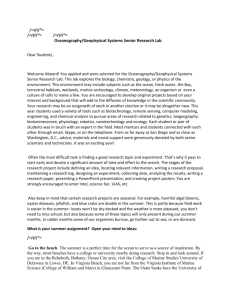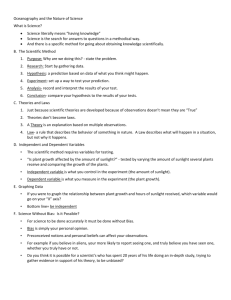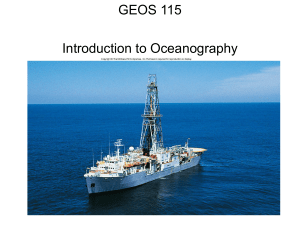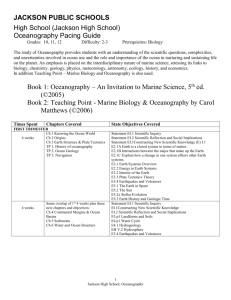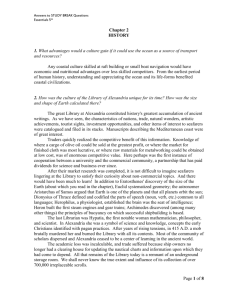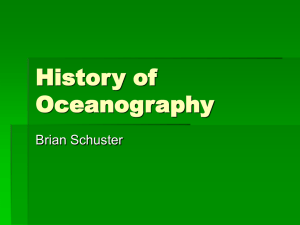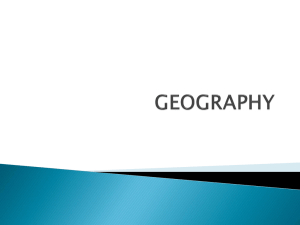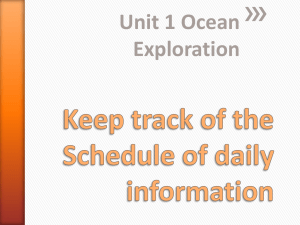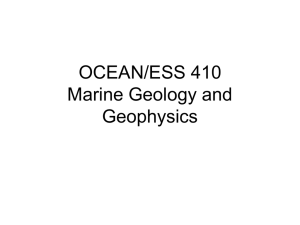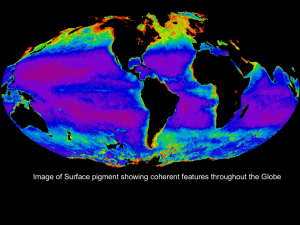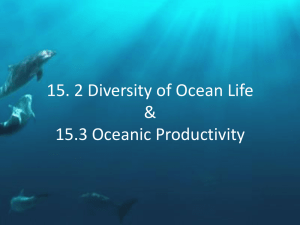History of Oceanography
advertisement
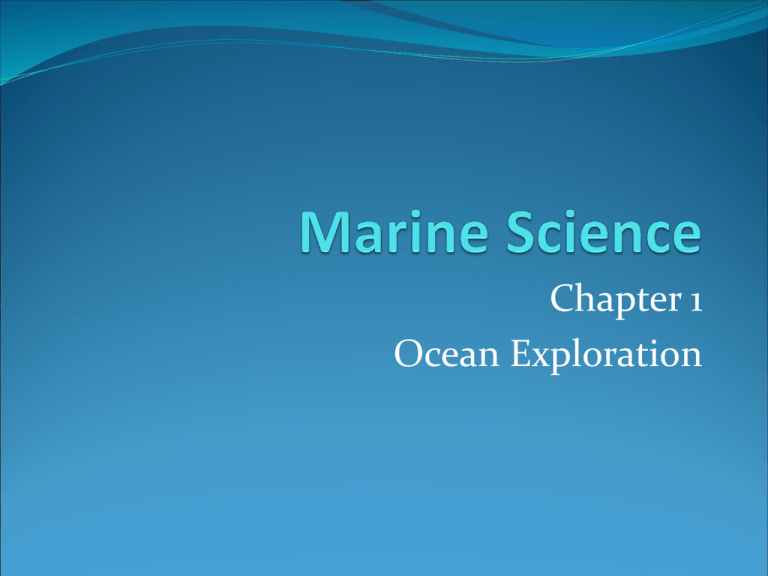
Chapter 1 Ocean Exploration Why Study It? Ocean extreme quiz? Ocean issues quiz? Why Study It? 1. The history of oceanography is connected to the world’s overall history. 2. Oceanography’s past helps us understand why and how people apply marine sciences today. 3. It is interesting. Top ten facts about the ocean Oceanography – the science of recording and describing the ocean’s contents and processes. There are four main branches of oceanography. Biological oceanography – studies life in the ocean. (species, predation, symbiosis, behavior) Chemical oceanography – studies the chemistry of seawater. (pH, density, pollutants, salinity) Geological oceanography – studies the geology of the ocean. (underwater mountains, trenches, map making, plate tectonics, ) Physical oceanography – studies the physics within the marine environment. (waves, tides, earthquakes) “For the execution of the voyage to the Indies, I did not make use of intelligence, mathematics, or maps.” Who do you think said this? Knowing what we do about Columbus’s mistaken ideas of land he discovered, why is this statement amusing? Columbus knew he wanted to west from Spain, so he used compasses. Why didn’t a compass direction help Columbus realize he hadn’t landed in Asia? How did sailors before Columbus find there way around the ocean????? It’s important to know where you in relation to other things, as well as the direction you are heading— This is why we use maps and globes… …But how do we read a map or know where we are on a globe? Latitude/Longitude System The purpose of the latitude and longitude mapping system is to identify specific locations on the Earth’s surface. Latitude Lines Also called parallels Run east-west 0º parallel is also called the equator Longitude Lines Also called meridians Run north-south Prime Meridian is located on the longitude of the Royal Naval Observatory in Greenwich, England. 00 longitude Further Accuracy Degrees are subdivided into 60 minutes, minutes are subdivided into 60 seconds. http://olc.spsd.sk.ca/DE/k9mod/Mapskill/ mod3fl5.swf The history of oceanography can be divided into four stages: 1. Ancient Seafaring (5000 B.C. - 800 A.D.) 2. The Middle Ages (800 - 1400) 3. European Exploration (1400 - 1700) 4. 20th Century Marine Science (1700 present) 1) Ancient Seafaring Three primary reasons for early civilization to interact with the ocean: 1. To obtain food. 2. To discover new lands. 3. As a means of trade. The earliest recorded sea voyage appears to be 3200 B.C. under the Egyptian Pharaoh Snefru. Greeks The Greeks used references on shore to navigate. This is called piloting. As seafaring advanced they learned to use the sun, constellations, the North Star and sea conditions to navigate in the open ocean. The Greeks knew the Earth was a sphere, not flat. Greeks cont… Pytheas (314 B.C.) predicted tides in the Atlantic based on the phases of the moon. He could determine how far North or South one was from the North Star by measuring the angle between the horizon and the North Star. This was a significant improvement in navigation. Eratosthenes (264-194 B.C.) is credited with two contributions: 1. He calculated the Earth’s circumference (however, incorrectly). 2. He invented the first latitude/longitude system. 2) The Middle Ages Viking Explorations and Discoveries The Vikings were the only people with significant exploration taking place in Europe during the Dark Ages: They discovered: Iceland in 700 AD Greenland in995 AD Vineland (Nova Scotia) 1000 AD Chinese Discoveries in the Middle Ages Magnetic compass dating about 1000 A.D Chinese ships from that period had central rudders and watertight compartments. 3) European Voyages of Discovery The period of 1400-1700 is called the Renaissance. A new interest in long ocean expeditions and travel in the 15th century was motivated by economics, politics and religion. Prince Henry the Navigator of Portugal established a center to study navigation. His expeditions were the 1st European to use a compass. Europeans cont… The New World Christopher Columbus took the first of his four voyages to find a route to Asia in 1492. He believed he’d found Asia when he landed on a Caribbean island. Between 1454-1512, Amerigo Vespucci is credited as the first European to recognize that South America was a new continent. In 1519, Portuguese explorer Ferdinand Magellan led the first expedition to circumnavigate the world. He had five ships and about 260 men. Only 34 men survived the journey, Magellan was not one of them. : ( st 1 Oceanography 1770’s - The voyages of Captain James Cook receive credit as the first sea expeditions devoted to methodical, scientific oceanography. He discovered Australia, New Zealand, many islands in the South Pacific, the Hawaiian Islands, charted the Great barrier Reef and took notes on human, animal and plant life. A major contribution to Cook’s voyages was the invention of the chronometer. In 1735, John Harrison invented a clock that runs accurately at sea. This made it possible to determine longitude accurately. U.S. Exploring Expedition -1838 Commanded Lt. Charles Wilkes aboard USS Vincinnes. Proved the existence of Antarctica. Returned with 19 volumes on new maps, descriptions, and illustrations. 1st time scientist were PAID to explore the oceans The Father of Physical Oceanography Matthew Maury Between 1842-1855, Matthew Maury earned global acclaim for his study on ocean currents. In 1855, he published The Physical Geography of the Sea, which is now considered the first textbook on modern oceanography. Charles Wilkes Matthew Maury The HMS Challenger Expedition (1872-1876) Recognized as the first worldwide oceanographic expedition. Expedition devoted entirely to marine study. Scottish professor Sir Charles Wyville Thomson and British naturalist Sir John Murray. Among its discoveries, the expedition: Deepest soundings taken to date – 8,200 meters (26,900 feet) in the Marianas Trench. Discovered marine organisms in the deepest parts of the ocean, contrary to popular belief at the time. Compiled the first systematic plots of currents and ocean temperatures. Cataloged and identified 4,717 new species. Read pgs 18-20. You do not need to write the questions. Answer in complete sentences. 1) How did European explorers find latitude at sea? 2) How do you find longitude with a clock? 3) Why was it hard to find longitude at sea? 4) What happens to clocks at sea? 5) What did the British government do in 1714? Whatlongitude were the requirements for the prize? Read6)“the problem” pgs 18-20 so that Who solved the you 7) may answer theproblem? following questions. 8) What was his invention called? 9) Why didn’t he get paid after winning the prize? 10) When did he finally get paid? 11) What event allowed him to get paid? 12) Where are his 4 inventions located today? 13) Why is that site significant? 4) th 20 Century Marine Science The Industrial Revolution spearheaded the growth and expansion of marine sciences. This included: Better ships made of iron with steam engines. Improvements in the design and building of research equipment. The advent of the submarine. Global conflict helping to accelerate research in science and technology. Three th 20 Century Expeditions The German Meteor Expedition (1925) Mapped the Atlantic seafloor with echo-sounding technology. The U.S. Atlantis Expedition – 1931 The first ship specifically designed and built for ocean studies. Confirmed the existence of the Mid-Atlantic Ridge and mapped it. The H.M.S. Challenger II Expedition – 1951 Found the deepest known part of the ocean. At 10,838 meters (35,558 feet) deep, still the deepest known place in the world. This spot, located in the Marianas Trench, was named Challenger Deep in honor of the first Challenger expedition. Use Table 1.1 on pg. 32 to create a timeline. Include the events that occurred on the following dates. Color code and label the 4 oceanographic stages. 100 yrs = 1 cm 300 BC 230 BC 127 BC 500 AD 70 YRS = .7 cm 103 YRS = 1.0 cm 627 YRS = 6.3 cm 1768 1831 1855 1872 780 AD 1911 1492 1943 1522 1977 1760 1985 Modern Oceanography Newer devices for scientists Echo sounder that bounces sound waves off the ocean floor are used to study depth and shape of the seafloor Satellites in space help relay information and track location with GPS Remote submersibles go to deep ocean to explore without the need for humans Oceanic Institutions Early laboratory in Naples, Italy allowed study of the ocean without being in the ocean 1912 - Scripps Institute was created in La Jolla, CA 1930 - Woods Hole Institute was created on Cape Cod of Massachusetts Our local marine lab is Grice Marine Laboratory Located at Ft. Johnson on James island. Operated by the College of Charleston. Famous Modern Oceanographers In 1943, Jacques Cousteau introduced the first practical scuba. Robert Ballard found the Titanic(1985) and other wrecks. Lee Spence discovered of the Civil War submarine H.L. Hunley in 1970.
